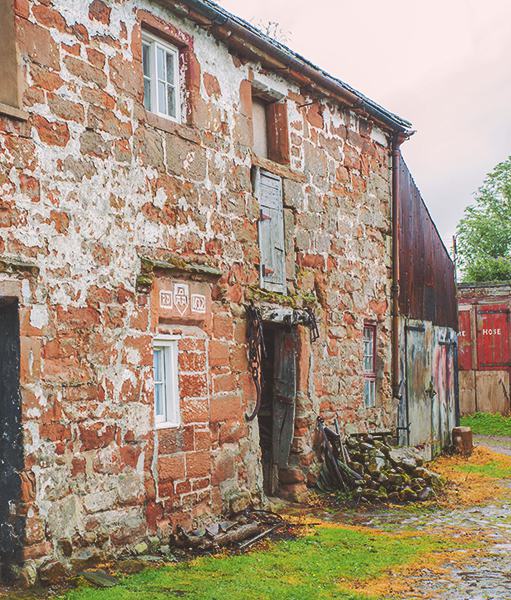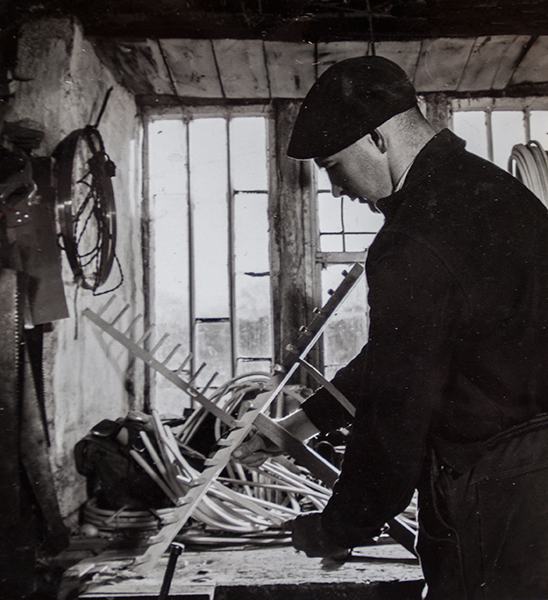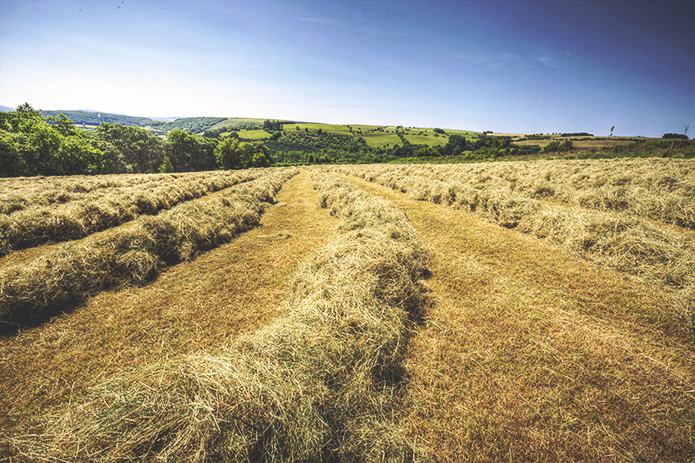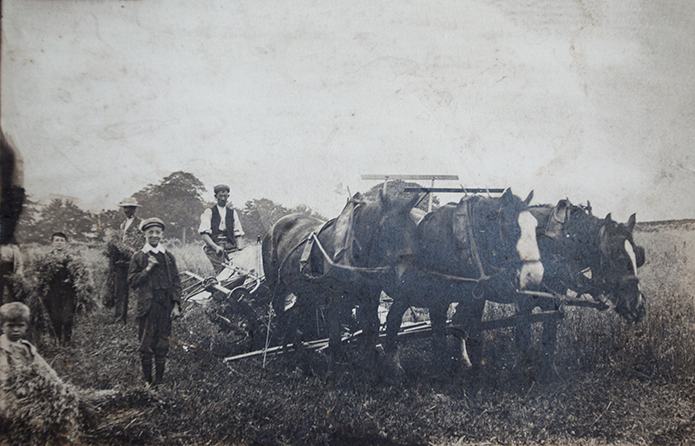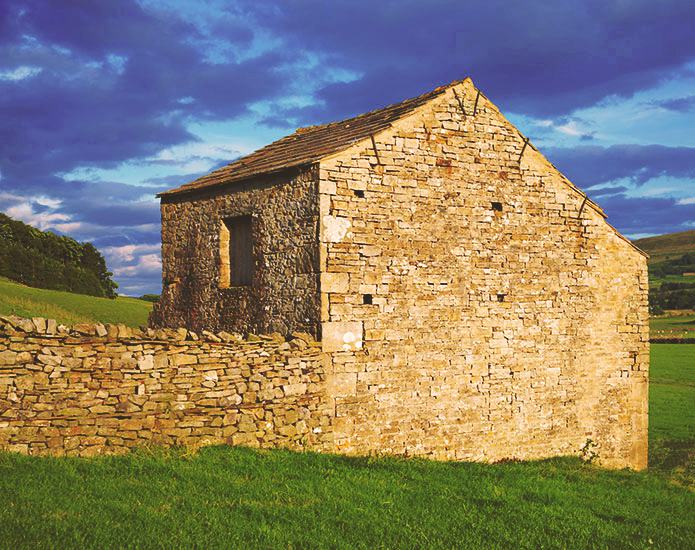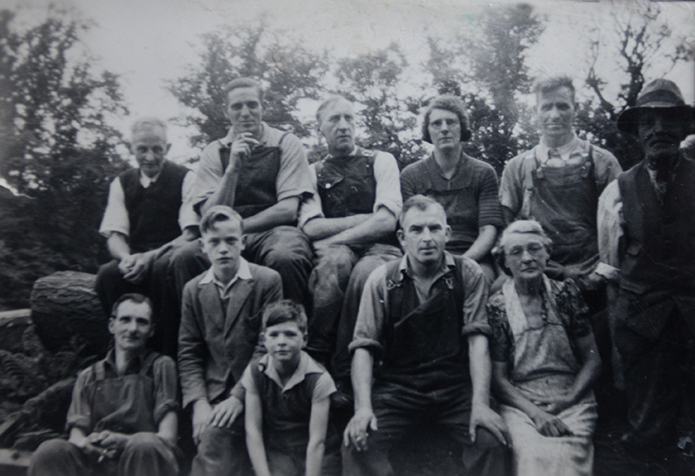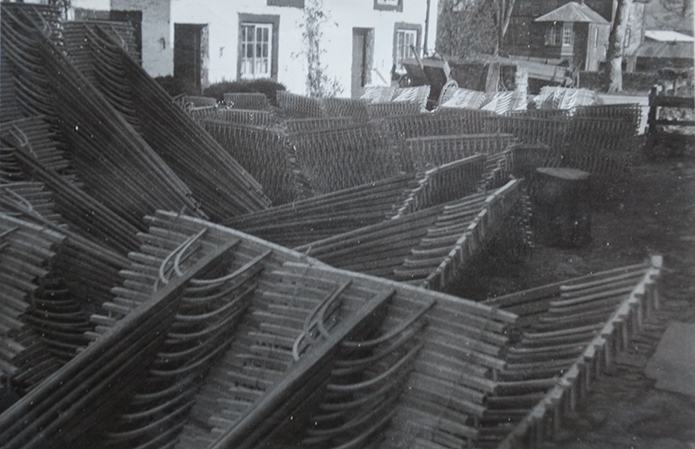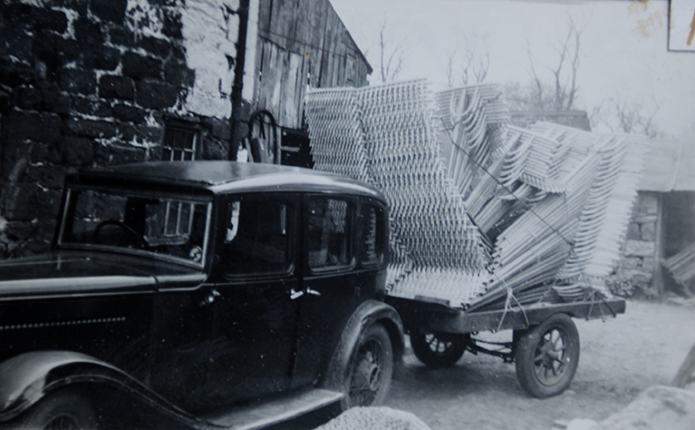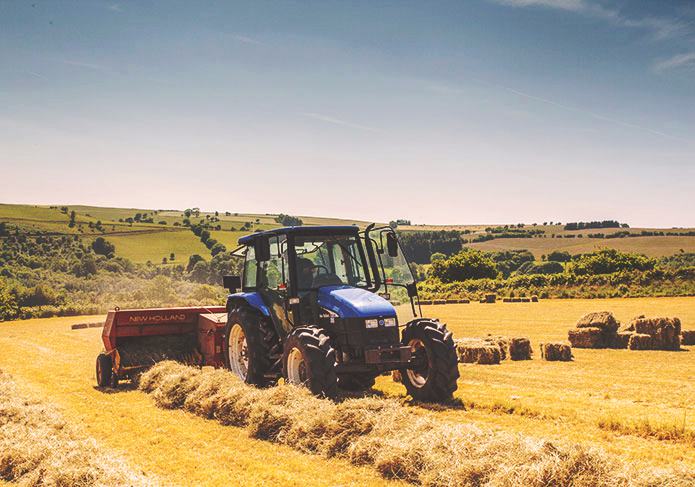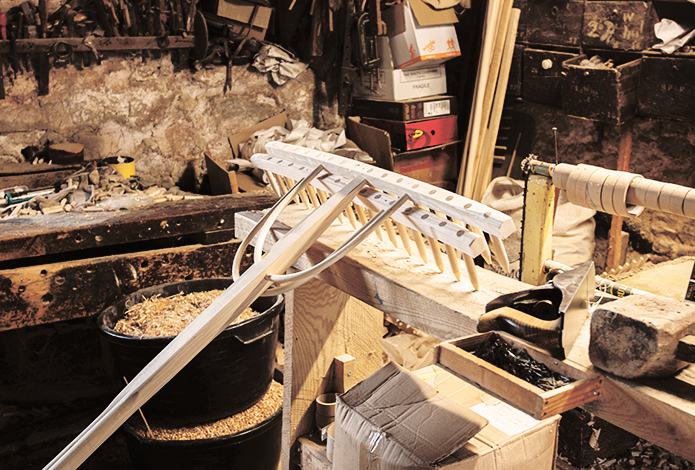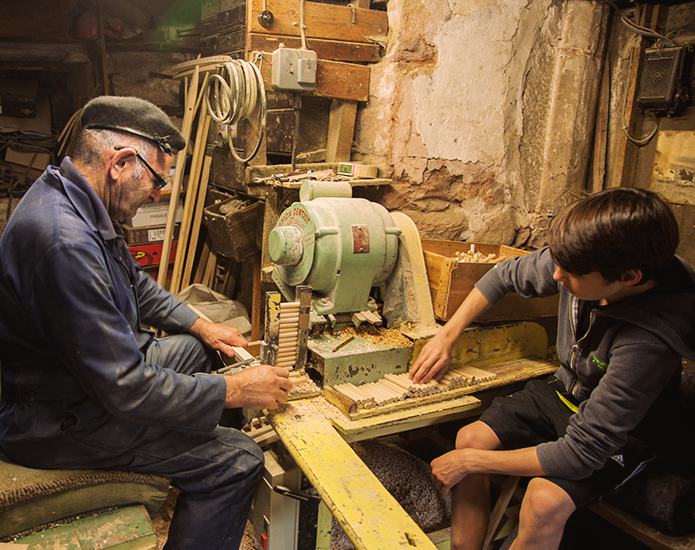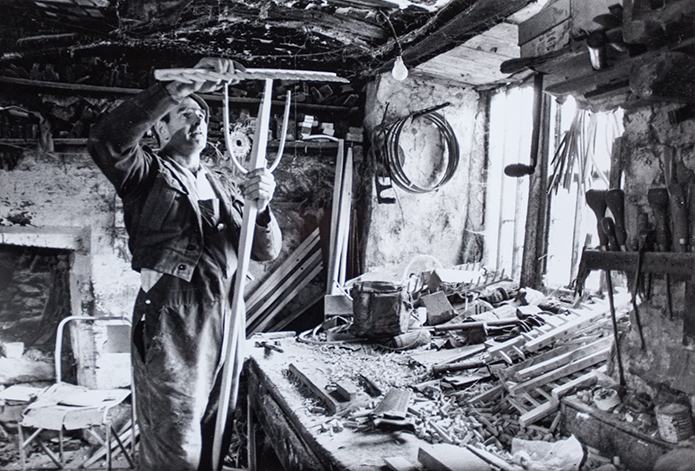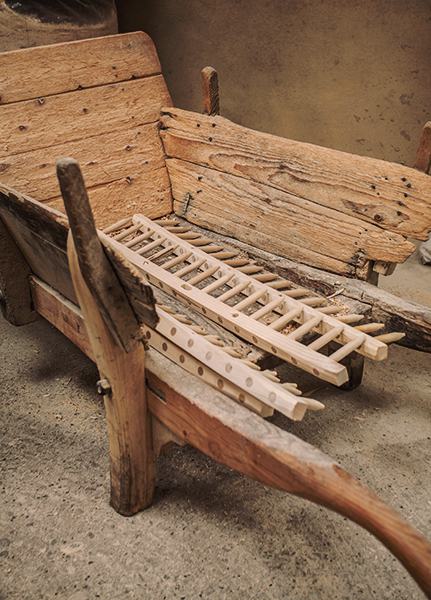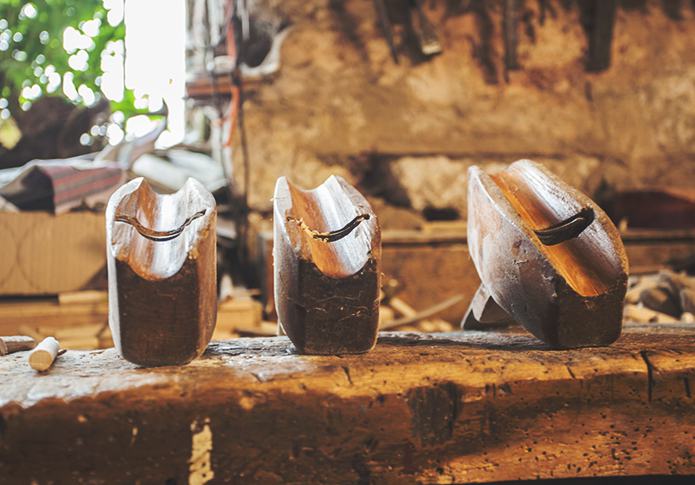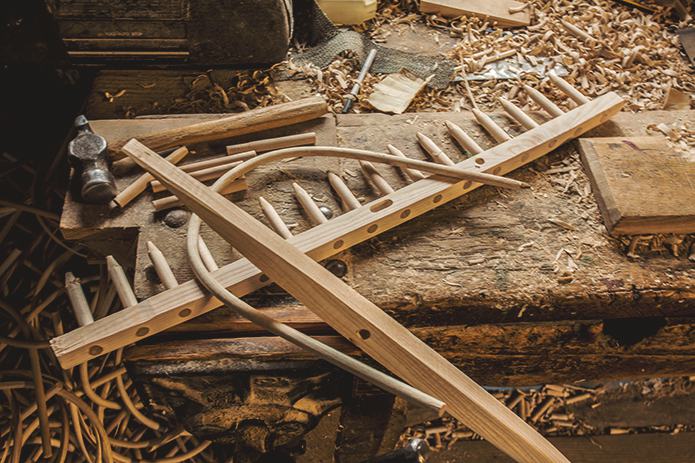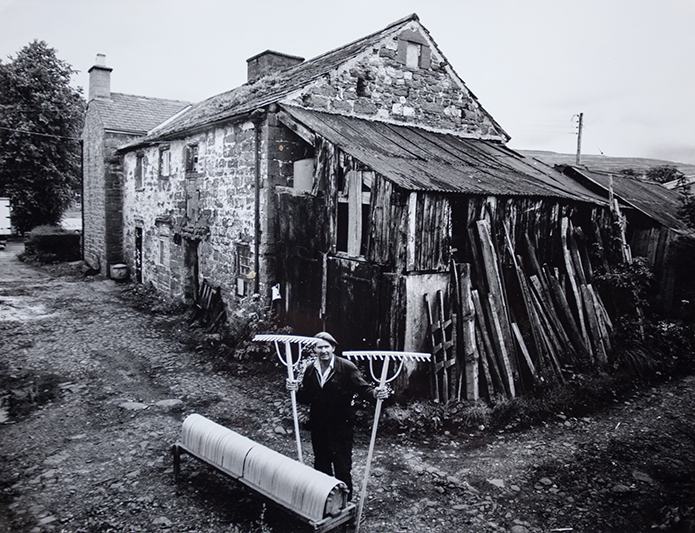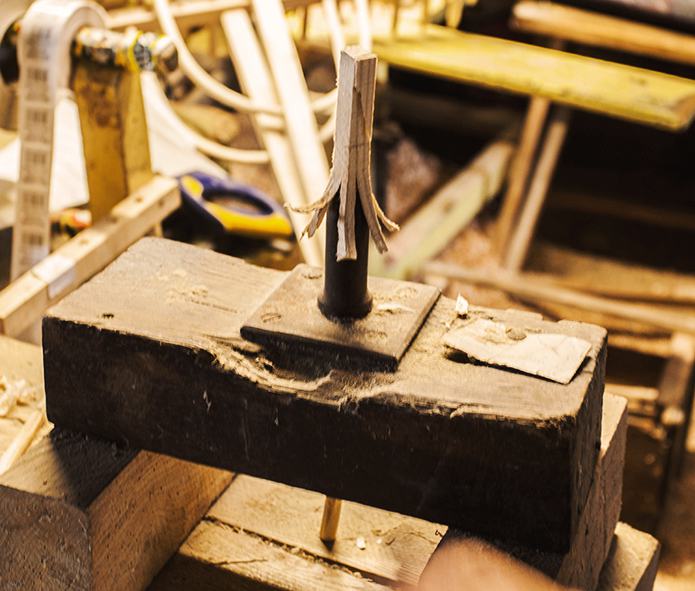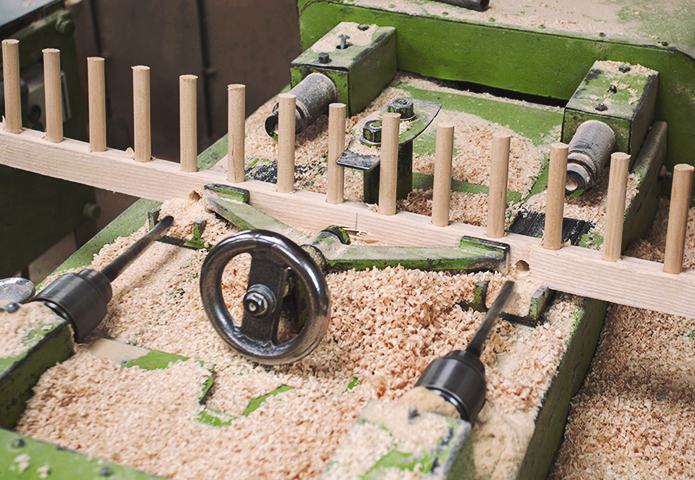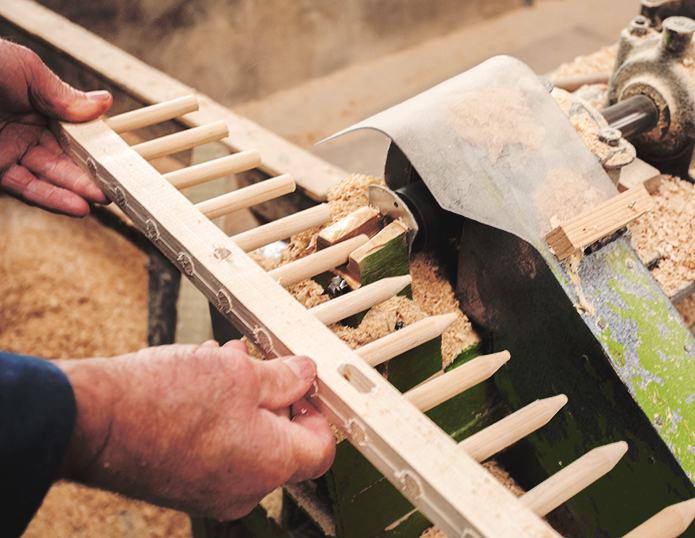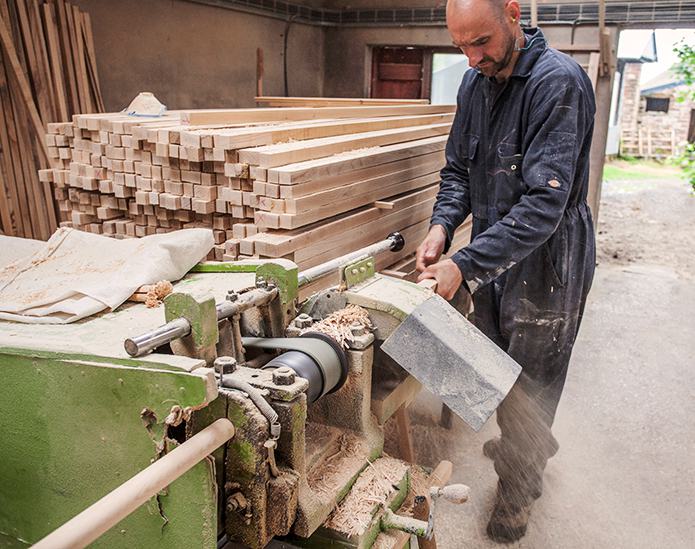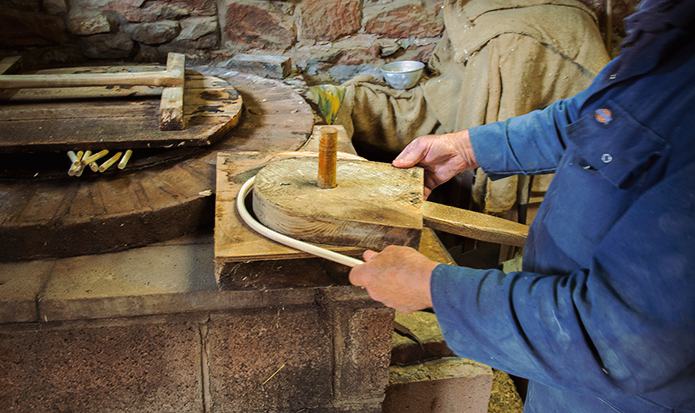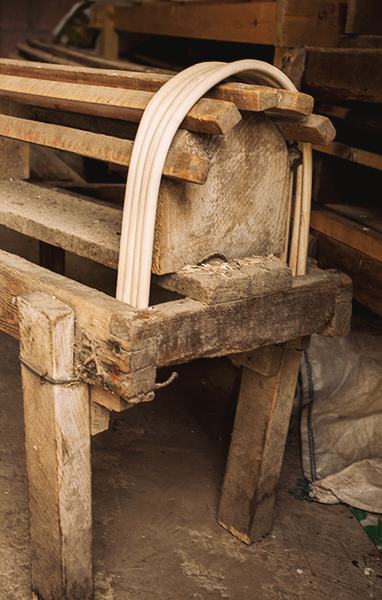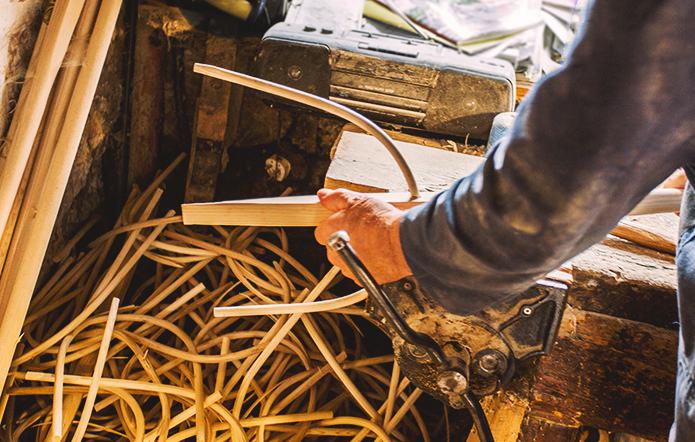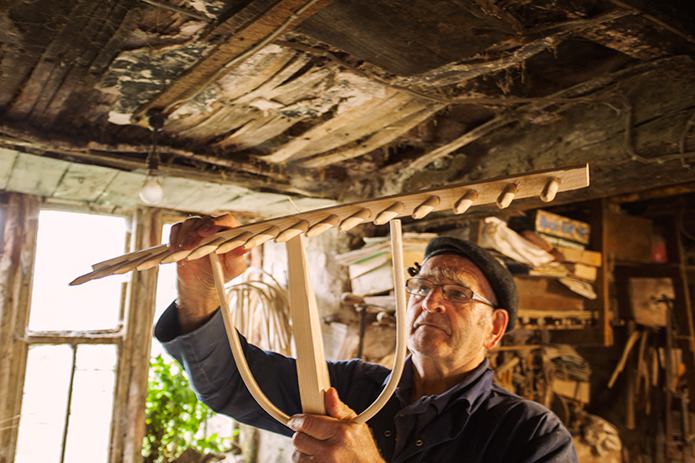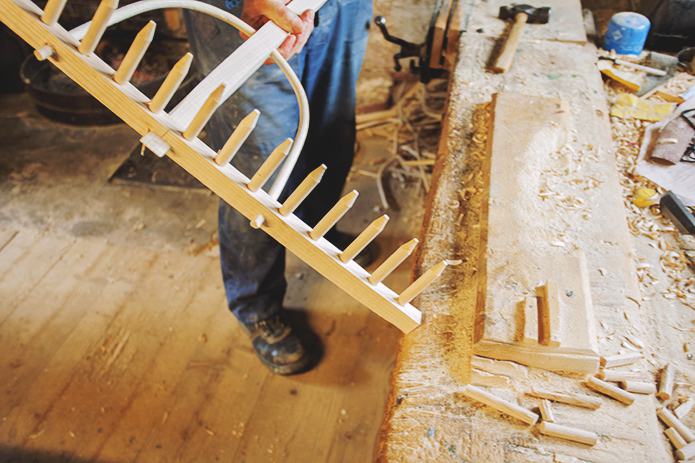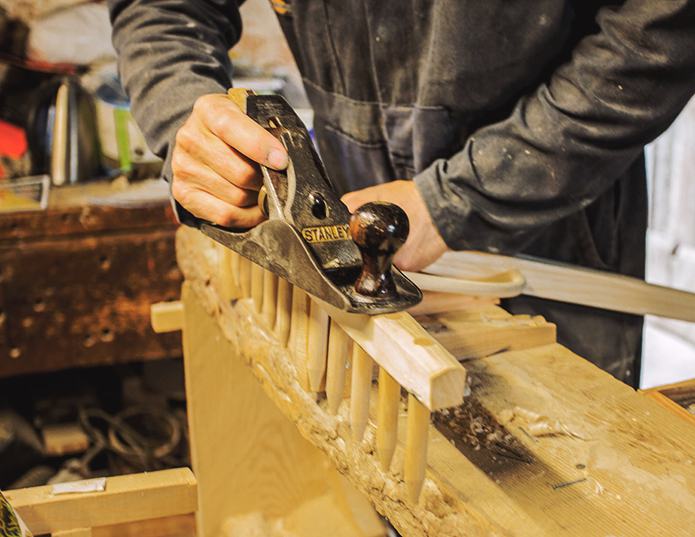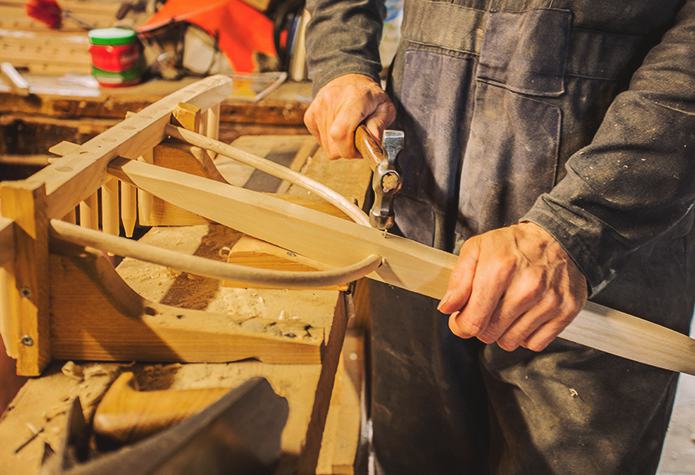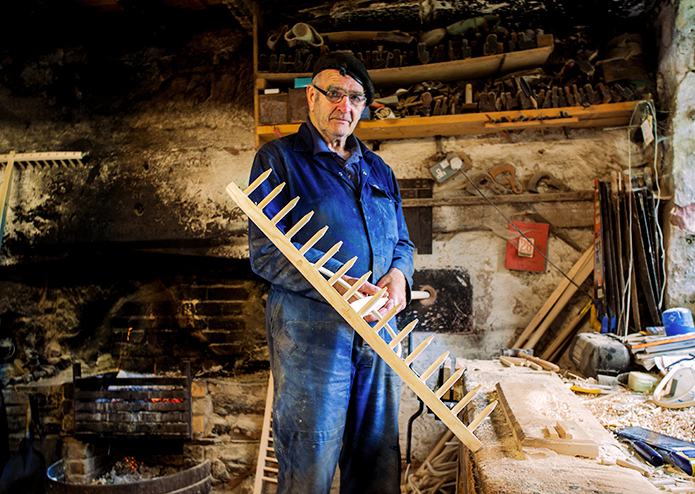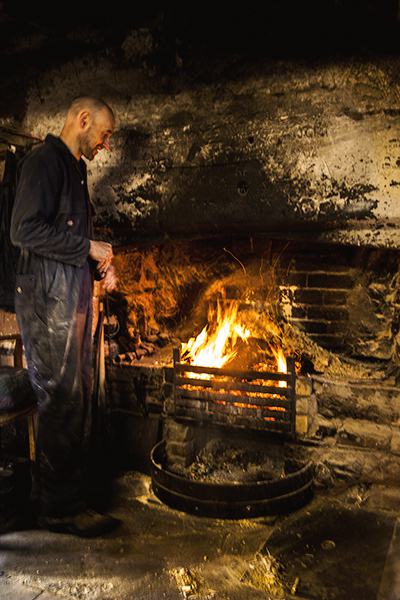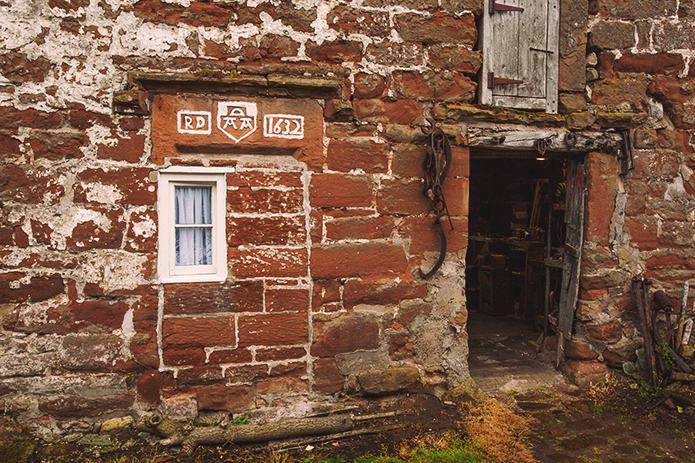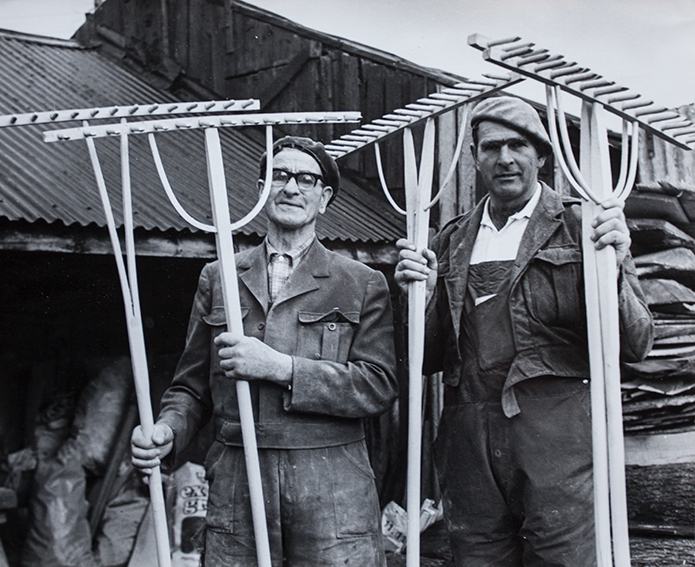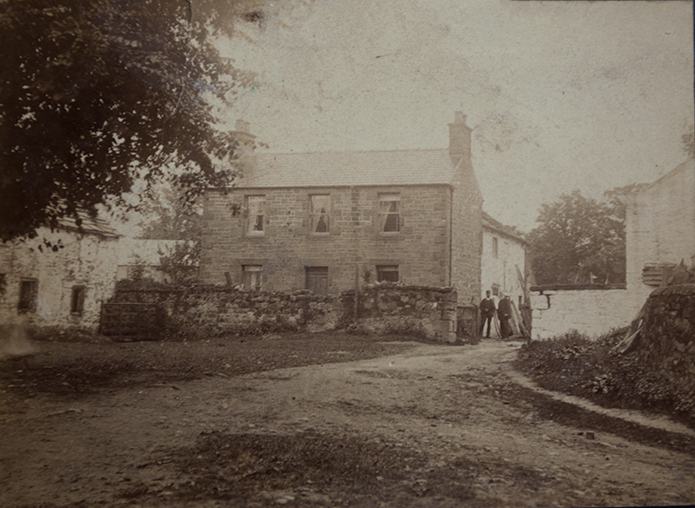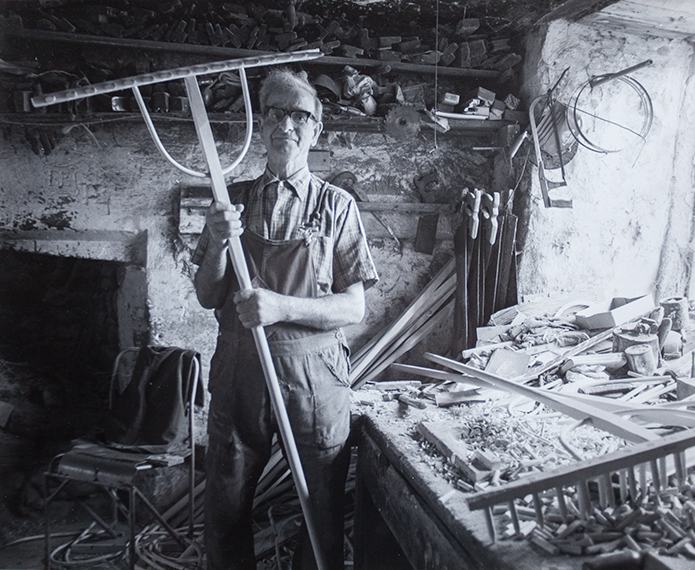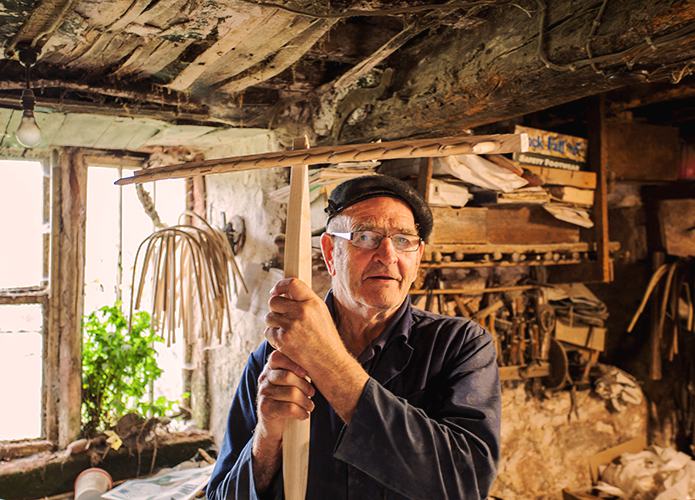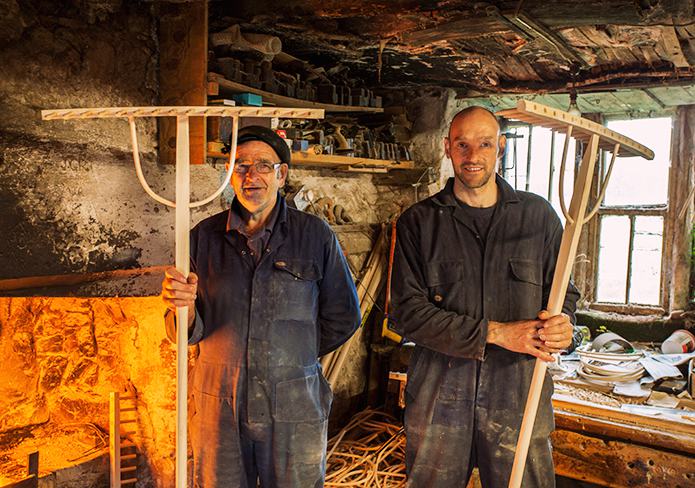
John Rudd (left) and son Graeme Rudd; 3rd and 4th generations of Rudd’s Rake Factory, Cumbria.
Gathering autumn leaves upon a suburban lawn, tidying displaced gravel on a driveway, hiding the evidence after a wayward golfing shot into a bunker or prepping a pit for leggy long-jumpers, all these modern day – one could say ‘trivial’ – uses of a wooden rake belie the importance of one of its original uses as a vital tool within the arsenal of hand-tools used within traditional working farms. Up until the end of World War Two, before the mechanisation era of the 1950s and 1960s, a wooden hay rake was an invaluable implement within the farming calendar, aiding the labour intensive process of gathering in the hay dry, before the inevitable turn in the weather, to ensure the livestock had enough feed stored to last the long winter and the farmer’s livelihood protected for another year…
Those days, when rural areas were ruled by events dictated by the cyclic seasons, are sadly all-but disappeared, with farming, family and community bonds diluted, and time-honoured rural-crafts lost and lamented. However, in a small corner of Cumbria, woodsmoke and warmth of an open hearth, quiet companionship amongst the clatter of tools, remains curiously constant in a 17th Century barn. The thick walls and heavy beams of this Dufton barn have witnessed a family legacy of rural craftsmanship which has stood the test of time, and now 3rd and 4th generation wooden rake makers, John & his son Graeme continue the family tradition, producing thousands of handcrafted wooden rakes, from local and European ash and birch, woods associated with their respective flexibility and strength – not unlike the men that fashion such iconic tools from their grain.
Proudly retaining the ‘old ways’ of the craft, which once would have occurred in every village in the country, eschewing contemporary cutting of costs and corners and modern materials, some twenty stages of production are still meticulously undertaken by Rudd’s Rake Factory, with a couple of hand-operated machines, the only nod to the modern age, installed recently, well relatively speaking, in the 1950s!
John Rudd, of Rudd’s Rakes, the last remaining traditional rakemakers in the UK, relays rake-making – past and present – to us here in this delightful interview in which he gives a unique insight into British rural history as well …
Firstly, for those readers that aren’t familiar with Rudd’s Rake Factory, can you explain what you do and the products you make?
We make traditional wooden rakes from our workshop in Dufton village, Cumbria, and have been in business since 1890. I’m the fourth generation in the Rudd family to have owned the company, and I work very closely together with my son, Graeme. We produce about ten thousand wooden rakes each year; traditionally these were used mainly as hay rakes, but now they have a much wider use. Our rakes are all hand-crafted from ash and silver birch, and are designed in such a way that the curved bow gives a superior head strength compared to other rakes.
Given the changes in agriculture over the past few decades, I imagine the demand for rakes for haymaking isn’t what it once was. Can you give some insights into how farming has changed over the years?
The changes in farming practices over the decades has definitely affected the demand for rakes for haymaking, to the extent that we don’t really consider ourselves as “hayrake” makers these days, but rather “wooden rake makers”. However, in the past hay rakes were an essential tool for farming up until about 40 or 50 years ago. When I was a young man, hay rakes were commonly used by people working the land for making hay. We still make hay these days, but nowadays we have specialised machinery to do it, whereas several decades ago it was still very labour intensive.
Hay would be stored in barns or byres for feeding animals in the winter but would be made a few months previously in the summer by growing grass for about six weeks in the spring and then cutting, drying and storing in the summer. In the days before cutting machinery, grass would be cut by men with scythes, which would be allowed to dry in the sun, turning every so often by hand using hay rakes and horse drawn turners.
When horse drawn mowers were introduced, scythes would still be used in inaccessible places, such as corners of fields – known as cutting the “dyke back”, as no opportunity would be lost to gather as much hay as possible. Once dry, the hay would either be gathered by hand using hay rakes and piled into hay cocks, which are mounds of hay, ready to be forked onto a cart and taken back to the byre, or the hay would be raked by hand into rows ready for a horse-drawn hay sweep to collect it – a sweep is a 10-12 foot long ‘rake’, for want of a better word, which would be placed between two horse and would gather or ‘sweep’ the hay in front of it as the horses walk along. If there was a byre in the field, then the hay would be swept straight into the barn, or placed onto carts or a hay sledge and either carried or dragged to a nearby barn.
If the hay was still damp – or ‘green’ – then it would be raked by hand into hay pikes, which were piles of hay anything from 6 feet to 12 feet high which could remain outside before being taken to a barn at a later date. They would either be covered from the rain with Hessian which would be weighed down with rope and stones, or stacked and thatched in such a way that the rain would run off. The ‘rope’ was made from hay, which was made by attaching some hay around two teeth in the rake and then twisting the hay, with someone else feeding loose hay to spit it out as rope. Once enough length of rope was made, it would then be thrown over the top of the pike with a rake and tucked in to keep the top from blowing away. The pikes could be moved by putting a rope or chain around the pike and either dragged across the field to a barn or winched onto the flat bed of two-wheeled cart pulled by a horse called a ‘pike pogey’ using a ratchet pulley; the pike pogey would be tipped up so the rear end would be touching the ground, and then the pike would be loaded onto the pike pogey with a winch and carefully balanced horizontally and taken back to the barn, with particular care taken on uneven ground.
As you can see, haymaking in those days was a very strenuous and labour intensive process, and there would be lots of people working in the hay field, probably half a dozen – including casual workers, the maid, the farmer and his wife. It was a major thing to get the hay in and it was all hands on deck during those few months to be able to feed the animals over winter. The farming community in those days was very close-knit, and farmers would often help out neighbouring farmers to get their hay in once they’ve brought in their own, or quite possibly they would work during the day on their own farms, and then the evenings on their neighbours.
Nearly every village would have had a rake maker in those days as there wasn’t a great deal of transport, so everything was made local. It wouldn’t necessarily have been a full-time job making rakes, but rather a joiner would make rakes as a seasonal product amongst other work the remainder of the year. Our output of assembled rakes was from the end of April to the beginning of July. From the middle of July we wouldn’t sell another rake until the start of the new season. During this time we would be flat out, working 12-18 hour days regularly, and we’d have about 8-10 part-timers helping us too, such was the demand for rakes during the busy periods.
The majority of rake makers would go back to other joinery work, such as repairing farm property, mending or making gates, putting in loft floors and mending doors on byres, repairing farming tools and implements such as the pike pogey, making hurdles, that sort of thing. They’d also need to prepare for the following seasons, such as maybe felling a hundred silver birch trees and putting them to dry and doing the same with ash trees, and then spending a couple of months making the parts ready for assembly for the new season. Sometimes rake makers from other villages would come to us to buy their parts for making rakes, and they’d assemble the parts themselves in their locality.
In addition to being a rake-maker, my father was also a wheelwright, and I remember even as late as the 1950s, carts would be entering our yard ready to have repairs carried out, such as replacing wooden wheels and axels. The rubber tyre changed everything which is why I never trained up to become a wheelwright.
I can still remember this way of life, but in the 1950s and ‘60s, all the horse-drawn jobs became replaced by tractors, such as mowing, turning, bailing and gathering. Hay sweeps became consigned to history with the invention of the bailer, and the joiner in our neighbouring village who made hay sweeps for a living would have lost his trade literally overnight.
Hay rakes, however, had more uses than the hay sweep so stayed on. Whilst hay rakes aren’t used any longer on modern farms, being far larger commercial enterprises, with advanced machinery, some traditional upland hill farms still do use hay rakes during haymaking time where small bales are still used (rather than larger silage bales), to rake up loose hay missed by the bailer, or where bailing twine has snapped on a bale and the bale fallen apart, so the loose hay can be raked into a neat row for the bailer to bale it a second time around.
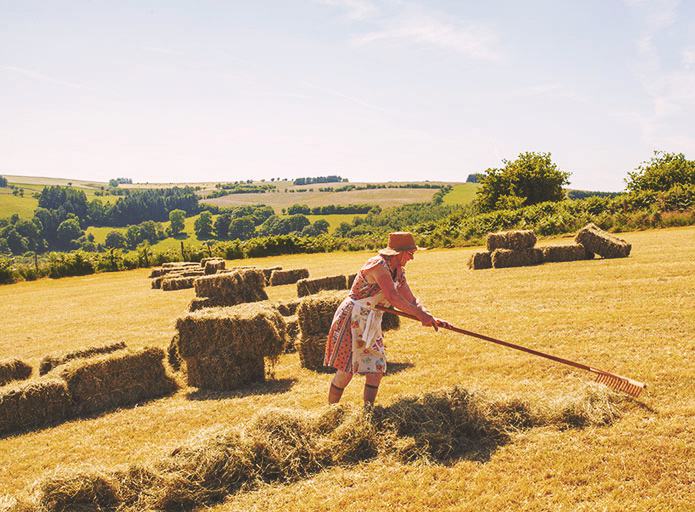
Modern uses for a hay rake in traditional upland farming communities; gathering loose hay for the bailer.
Who are your typical customers these days?
Our wooden rakes are used for a variety of purposes now. Aside from still selling some to the farming community, they are popular with landscape gardeners for levelling soil, for golf courses to smooth over bunkers, for smoothing over long jump pits on athletic tracks, raking up leaves and cuttings in domestic gardens, for the building trade, where builders use them for levelling fresh concrete, and we even produce a special version for Japanese Zen garden enthusiasts. We have also produced a V-shaped stick to restrain Komodo dragons for a zoo – so a long way away from our farming origins!
Whilst our market was once limited to the north of England, we now sell right across the UK, from Norfolk to Herefordshire. The majority of what we sell is to wholesalers such as ironmongers and agricultural merchants, as it’s easier for us to sell 100 to one wholesaler, than 100 to 100 individuals.
You come from a family of rake-makers; what age did you make your first rake and was it always your plan to join the family business?
My mother used to have to help out in the workshop when I was a child during busy periods, so after school, I’d often have to work there as well doing menial jobs when very young, and gradually doing more with age. I can’t remember exactly what age I made my first rake, but I certainly remember splitting my thumb when I was 9 years old hammering teeth in, so it can’t have been any later than that.
By the age of 11 or 12 I was regularly working after school and during Easter holidays, and by the time I was 15 or 16 I was working full-time, flat out. It was not really my plan to enter the family business, but in those days I didn’t really have a lot choice and it just happened.
Have your methods and techniques changed a great deal over the past century, and have you embraced technology to assist you?
Whilst the rakes still look exactly the same as they did a hundred years ago, we have used some hand-operated machinery to assist us to speed up some of the manual processes which were quite time-consuming.
Originally all of our rakes were made with traditional carpentry tools and methods, such as planing and boring wood by hand, but the first attempts to make things a bit easier for ourselves was when my grandfather in the early Twentieth century rigged up a steam engine with belting and shafting to power some saw benches, but that was before my time. Before mains electricity my father rigged up an oil powered generator to provide power using belting for drills and a sanding machine for sharpening the teeth.
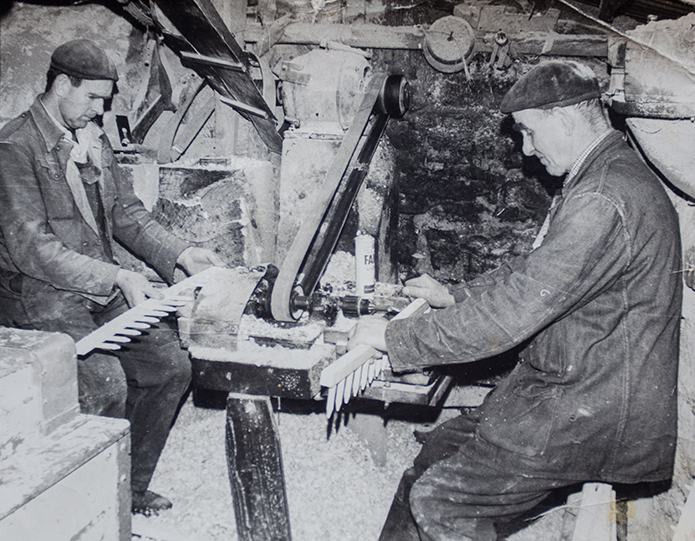
Early improvised machinery power by oil powered generator before mains electricity. Image courtesy of Rudd’s Rakes.
The biggest innovation to help us improve productivity was when my father introduced mains electricity into the workshop in the 1950s and with it the installation of some bespoke hand-operated machines with distinctive names such as the “Demon Dentist”, which creates holes in the rake head and inserts silver birch teeth into them fed by another person in one seamless process, and “Dusty Miller” which puts holes in the shaft for the bow to be inserted.
I think my father was concerned about the competition from mass-produced American rakes, and so he decided to improve efficiency and increase production to counter this, but he still wanted to maintain traditional craft skills rather than have the workshop completely automated.
What different types of wood are used in the making of a rake and why are certain woods preferred for a particular component part of the rake over others?
We use ash and silver birch to make the rakes. People may view men from generations ago as relatively simple people, but they knew all about their wood and the different properties of each and what they could be used for, and nearly every wood had a specific use.
Ash is one of only a few types of wood that can be bent, which we use to make the bow – the hoops that go through the handle (the “shaft”) and fix into the head. The length of ash wood closest to the ground, the “butt” or bottom of the tree, is the most flexible, and we use this wood to make the bow. Wood from higher up the tree can be used to make the head or the handle. The teeth of the rake are made from silver birch. Silver birch is a very hard wearing wood, and it needs to be to withstand the wear and tear that the rake goes through, but to my knowledge it wasn’t used for much else as it grows tall and thin, so not really practical for other purposes, unlike ash which grows with a wider circumferences, and so you can get a lot more out of it. The silver birch is warmed and dried before we use it, so that it doesn’t dry out when fitted to the head and the teeth fall out, whereas the ash rake heads are made from relatively ‘green’ ash, so when it dries out further, it shrinks onto the teeth; it’s the same philosophy behind oak timber framers that use green oak in the main construction but use dried out pegs to lock the cut timbers into place.
In the early days of the business, all of our wood would have been sourced locally from seasoned coppiced ash and silver birch. If the wood wasn’t quite straight enough for the shaft, it would have been straightened by steaming and clamping, before being hand-planed.
To speed up production, years ago we started buying-in Columbian pine from North America for the shafts, as it was faster for us to work with nice, clean and straight ‘squares’ of wood which we could shape into handles easier, rather than us having to source and straighten all the wood ourselves. Columbian pine became very expensive, and in fact the quality became worse, so we stopped using it. We then started using Ramin from Malaysia, but stopped importing that as well as they couldn’t provide us with a deforestation certificate, and so finally we opted for European ash for the handles, which is grown sustainably in Germany and is of the quality that we require, but we still use home-grown local English ash for the rake heads and bows. We could make the squares for the handles from local wood but for the quantity and quality that we require it’s cheaper for us to source this from mainland Europe than from British woodlands sadly. However the rake heads and bows are from nearby Yorkshire ash.
How do wooden rakes compare to those made from other materials, such as plastic or metal?
I’ve always believed wood is better, but that’s because I work with wood, so I’m probably biased. I do believe it creates a better balanced rake, and wood floats over the surface better and won’t sink in like metal-headed rakes, which are very heavy. For farm workers operating in the fields all day, to have carried a rake with a head 2 feet six inches wide made from iron or steel would have been far too heavy to handle all day.
I’m not sure about the properties of plastic, but can only imagine it’s fairly brittle, and I don’t think can be repaired like a wooden rake. I think if you were to ask a selection of people to try out each different type of rake, the majority would favour the wooden one.
Can you briefly describe how you would make a rake?
To make a finished rake requires twenty different procedures and a lot of sawdust!
Rather than making one rake at a time, we’ll do all the main stages in batches, such as making the bows and heads, and then assemble them individually. We worked out the time saving, and we can produce twice the amount of rakes doing it this way than individually in the same time frame.
The main stages of production commence with making the rake heads by planing all four sides on a planing machine. The head is then taken to the Demon Dentist which simultaneously creates the hole in the head and firmly inserts the silver birch teeth, which are in turn made from silver birch dowels cut from logs. There are 16 teeth for each rake head.
In the past, before we used dowels, we used to cut silver birch into 4 inch long logs, which we chopped up into square, thin lengths, which was a simple process as silver birch splits very easily. We then hammered the square peg through a round hole of a metal die made from a length of iron pipe which had a sharpened rim positioned over a bench. When hammered from above, the wood would be forced through the circular pipe and would fall out the bottom of the pipe onto the bench perfectly round and smooth. These teeth would then be inserted into the holes of the rake head which would be hand-drilled and then driven home with a mallet. Using dowels is much quicker for us now though.
Holes are then drilled into the rake head ready for the shaft and bow to be inserted.
The rake head is then taken to another machine whereby the ends of the teeth can be sharpened.
The squared shaft is rounded using a planing machine with the exception of the end nearest the head, which is left squared, and this is then sharpened at the end ready to be inserted into the rake head, and hole is drilled for the curved bow to be inserted.
The curved ash bow is made by taking a length of straight, but round, ash, and inserting into an ancient water-filled iron boiler which is suspended above a fire and heated up to make the ash supple enough for bending. The ash bow is retrieved after about 10 minutes and bent into a half-hoop and placed on a ‘former’ which allows the steamed wood to cool down whilst maintaining its bent shape.
In the past, before we used round pieces of ash, we bent wider pieces of flat ash, which we would cut and divide to create three separate bows, but now we make bend them individually, and I think a round bow is slightly stronger than a square bow, as it is cut to the grain.
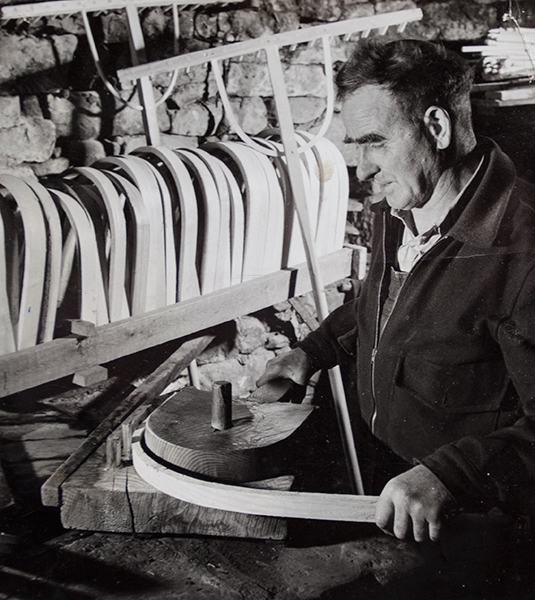
Flat ash being bent to shape prior to being split into 3 separate bows. Mid-20th Century. Image courtesy of Rudd’s Rakes.
The bow is then inserted through the pre-drilled holes in the shaft…
…and attached to the rake head.
To ensure the rake head and shaft are squared accurately, the handle end of the shaft is inserted into a hole in a large stone fixed into the wall of the workshop and the rake is spun around and both ends of the rake head must reach a certain mark inscribed on the edge of an old adjacent workbench.
Provided it passes that test, it is ready for planing to give it a smooth finish…
…prior to fixing with four small nails.
If not, we can make some minor adjustments so that it can pass the test next time. We don’t use any glue or wire in the making of our rakes and the strength is all in the design, which has stood the test of time.
After a period of time being stored in a warm, dry environment, the rake may start to feel loose, and this can be quickly remedied by inserting the rake head in water, which allows the wood to expand and tighten up the joints again.
I understand you work in an ancient building; can you describe your workshop and in what way does it influence your work?
Our building dates from 1632 AD, and it was once part of a dwelling house, but it’s been a workshop all my life, and as far back as anyone can remember in my family. The old workshop is just one room, with flagstone floors, oak beams, thick walls, with an open hearth which is always lit which makes for a nice and cosy working environment. It has lots of character, and it’s the only place I’ve ever assembled rakes in, and can’t imagine doing it in another building. We can just stoke up the fire with off-cuts of wood and shut the doors and be happy getting on with the tasks at hand.
In additional to our assembly workshop, we also have a more modern workshop with some of our original old machinery from the 1950s to help us, but this workshop burnt down a few years ago, and had to be rebuilt. Surprisingly most of the old machines survived the fire, which shows how robust they are.
Are there different designs of rake you make, perhaps for different parts of the country or for different purposes, and do you specialise in a particular style?
Years ago we tended to do more designs to cover variations in regional style, but now the range is more limited. The standard design for the Dufton area, for instance, is for a 6 feet long handle, 2’ 6” wide rake head, and 16 teeth, but we have a customer in Kendal 30 miles away who insists on having 12 teeth, as that’s what he was always used to in his locality. Differences in regional design were down to the style of the individual joiner and some would prefer a round bow, others square, variations in the number of teeth etc.
We do our standard solid shaft, as well as the Y Shaft / Split Shaft variation, which is where the shaft is split and enters the head in two parts. We also vary the length of the shaft for particular purposes, such as making a 10 feet long shaft for harbour masters to drag detritus out of the water, and a 4 feet long version to level gravel, but they’re not in big numbers. Our Japanese Zen rakes, with longer and more spaced out teeth, with a narrower head, are also popular.
What is it like living and working in rural Cumbria, amongst the breath-taking Pennine hills?
I’ve never lived anywhere else, so can’t really make any comparisons. The winters aren’t too bad these days compared to the past, but we sometimes get isolated by snowdrifts.
With the changes in farming over the past decades, the community has definitely changed and it’s not the same as it once was. There were far more smallholdings a few decades ago, with some farms only 10-20 acres providing for a family, but now farms are hundreds of acres in size and far more economical. The land is still being farmed, but by far less farmers. Farms these days employ very few workers, and it’s either family members or contractors, whereas in the past most farms hired a number of farm hands or workers. The landscape has changed as well, and many of the rural byres and barns that were once essential for storing hay over winter have been converted into holiday cottages and Bed & Breakfast enterprises. I’ve also noticed a shift in the past twenty years whereby the people that bought character stone houses in the village as second homes whilst they were living away, have retired into their second homes, and it’s now their main residence.
As a result of these changes, there aren’t many Duftoners left. I think the bicycle started these change off – you couldn’t walk to Penrith 13 miles away to visit a girlfriend a hundred years ago, but with the bicycle, it meant people could travel further differences, and that really started the mixing of village communities. Taking my family as an example, the Rudd’s have been traced back to Dufton from as early as the 1600s, and it took some 400 years for them to have moved more than 8 miles away from Dufton, gradually moving outwards from village to adjoining villages. So in that context, my son Graeme who has moved 13 miles to Penrith recently has moved almost twice as far in one generation as the previous 20 generations added together before him!
As to village life, you often see young children playing in the village green in the centre of the village, which is nice to see, but when I was a young man it was a common sight to see groups of men in their 20s and 30s playing football on the village green, as there weren’t really any other activities to do in the village and it was too difficult to get anywhere else. That’s obviously not the case any longer.
How many people do you estimate are making rakes professionally today in the traditional way and what do you put your success down to?
As the rake maker a hundred years ago would have been the village joiner working on other projects, and only made rakes seasonally, for many of these joiners they viewed making rakes as a bit of a nuisance, and would want to go back to making products that they really liked.
However, my great grandfather actually enjoyed making rakes, so much so that instead of just making them for the local farming community, he would sell them to shops in Penrith which became popular with farmers in the surrounding areas, and so he started selling much further afield than just around the Dufton area. So his decision to specialise in rake-making, when most others didn’t, had a lot to do with the fact that the craft wasn’t continued by very many people.
I think what also helped the Rudd’s Rakes was my father’s decision in the 1950s to get electricity into the workshop and build some specialist machinery, such as the Demon Dentist, which allowed him to speed up some of the jobs that were very time consuming. I can’t imagine many of the other rake makers in existence at the time made a similar investment. So a combination of having a reputation within the farming community for making the best rakes, having the ability to specialise and embracing some machinery meant our company flourished whilst others didn’t.
To my knowledge, I don’t think there’s anyone else in this country making wooden rakes as a dedicated business. We’ve seen other wooden rakes from time-to-time, but they are a cheaper quality and have wire supports, and could well be imported from abroad.
How do you see the future for country craft businesses in general, and wooden rake making in particular?
People still appreciate the ‘hand-made’ rather than ‘mass-produced’, and having a product derived by someone simply pressing a button and ‘out comes the product at the other end’ doesn’t really sit well with many people. Having said that, for the people making hand-made products it’s got to be economical. I would said that of those involved in the craft-related industries, 90% have to be influenced by profit in order to survive, so if there’s demand for their products, they’ll continue doing it, and if demand goes below what’s economical, then the craft will disappear.
For us, there’s still interest in what we do and we’ll continue making rakes as long as that demand remains. Sure, there isn’t the same level of demand as there was 50-60 years ago, but in recent years it’s been quite steady. Fortunately, we’ve not had to think about diversifying into other products, as we’re fully occupied with making rakes, and we’re happy with that.
Thanks to John Rudd for taking time out of his busy schedule to answer our questions.

